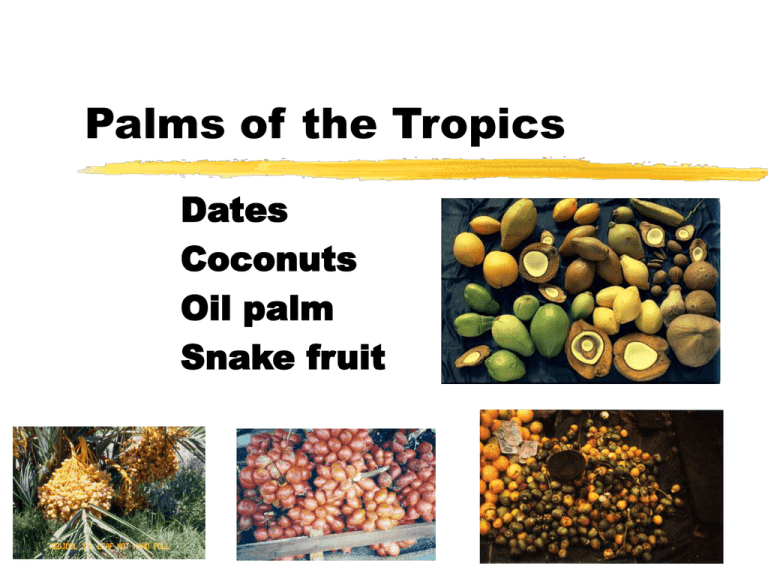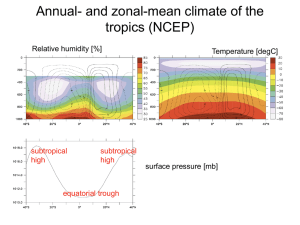Palms of the Tropics
advertisement

Palms of the Tropics Dates Coconuts Oil palm Snake fruit Relative Production of Palm Crops FAOSTAT, 2003 Crop Production (1,000 mt) Yield (mt/ha) Production increase since 1980 Dates 6,283 5.7 144% Coconut 50,858 4.7 56% Oil Palm 127,383 12.2 333% Tropical Horticulture - Texas A&M University Dates Palmae Phoenix dactylifera Vegetative Structure - Palms No cambium only growing point Growing condition record by sections not annual rings Single trunk without branches 50-120’ (up to 36.5m) tall Leaves - Date Palm 10-20’ long Life span of 3-7 years Roots surround leaf base Tropical Horticulture - Texas A&M University Fruiting Dioecious Pollinators - insects and wind Inflorescence - branched spadix Many long spikes Attached to fleshy axis Enclosed in hard tough spathe Burst open when flowers mature Large inflorescence - 6,000 to 10,000 flowers Tropical Horticulture - Texas A&M University Origin of the Date Palm (Phoenix dactylifera) Probably originated in Persia Gulf region and spread This is one of the oldest cultivated plants Zeven and de Wet, 1982 Tropical Horticulture - Texas A&M University Origin Persian Gulf region Especially between Nile and Euphrates rivers Not known in wild Movement West to Egypt and North Africa East to Western India One of oldest cultivated plants 8,000 years ago in south India 4,000 BC in Arabia Iraq (Ur) 3000 BC Tropical Horticulture - Texas A&M University Adaptation Hot arid climate with ample subsurface moisture Grows from 15° to 35° N latitude Full sun Temperature Dormant can take 20F (-6.7 C) Commercial growth • Mean daily maximum of 90F (32.2C) Tropical Horticulture - Texas A&M University Adaptation Hot arid climate with ample subsurface moisture Moisture Drought tolerant High water requirement for maximum yield • 4-6 acre feet per year • Since lose 20%, apply 7.5 acre feet Roots can withstand low O2 • Root structure permits O2 movement from surface No rain during ripening (checking = cracking) Tolerant of high levels of Alkali Salt Tropical Horticulture - Texas A&M University Tropical Horticulture - Texas A&M University 1998 1992 1986 1980 1974 FAOSTAT, 2003 1968 7,000 6,000 5,000 4,000 3,000 2,000 1,000 0 144% increase since 1980 1962 mt) Date Production (1,000s World Date Production World Date Yield Yield has decreased since 1962 FAOSTAT, 2003 6.0 4.0 Tropical Horticulture - Texas A&M University 1998 1992 1986 1980 1974 0.0 1968 2.0 1962 Date Yield (mt/ha) 8.0 Date Production Region Africa Asia Latin America USA Production (1,000 mt) 2,116 Yield (mt/ha) 7.4 4,135 5.1 4 4.4 21 9.4 FAOSTAT, 2003 Tropical Horticulture - Texas A&M University World Date Production Region Countries Production (1,000s mt) Africa Algeria 413 Egypt 1,078 Sudan 280 Iran 873 Iraq 633 Oman 259 Pakistan 624 Saudi Arabia 767 United Arab Emirates 759 Asia FAOSTAT, 2003 Tropical Horticulture - Texas A&M University Propagation Seedlings Variable - 50% female Must propagate from offshoots Date palm produce 2 offshoots per year for 10-15 years Harvest when 3-5 years old 40 - 75 lbs (18-34 kg) Sledge hammer and chisel Tropical Horticulture - Texas A&M University Planting Density 120/ha May lose up to 25% of planted offshoots 1 male plant for 50 female plants Precocity Blooms within 3 years First commercial crop in 5-6 years Young date palm orchard Tropical Horticulture - Texas A&M University Planting Precocity Full production 8-10 to 60 years After 60-80 years productivity decreases Tree growth 1-1.5’ (30-45 cm) per year By 15-20 years old is 20’ tall Tropical Horticulture - Texas A&M University Cultivars 1000s of cultivars in the world ‘Zahdi’ (Semi-dry) Leading cv in Iraq Oldest known cultivar Very popular in the mideast ‘Deglet Noor’ (Semi-dry) Introduced from Tunisia to California in 1900 75% of California production Medjool (Soft) From Morocco to California in 1927 Deluxe date grown in California and Arizona Vary in ripening time (3 months) so generally several varieties are grown Tropical Horticulture - Texas A&M University Pollination done by hand Minimize number of male plants 1 male 50 female trees Ensure good set Methods Traditional - put strands on flower Pollen can be stored and dusted on Metaxenia - male variety important Pollen source affects maturity, seed shape, and seed size Tropical Horticulture - Texas A&M University Hand Pollination Female inflorescence Traditionally done for thousands of years Tropical Horticulture - Texas A&M University Hand Pollination Male inflorescence 2-3 pieces tied to distal side of female inflorescence Tropical Horticulture - Texas A&M University Fruit Development About 29 weeks for development Low crop Heavy crop Tropical Horticulture - Texas A&M University Fruit development 29 weeks for fruit development Chimri - 1st 17 weeks Green, hard, bitter, 80% moisture, 50% sugars Khalal - weeks 18 to 23 Full size, yellow, orange or red color % sugars increasing, mainly sucrose Tropical Horticulture - Texas A&M University Fruit development 29 weeks for fruit development Rutab - weeks 24 to 27 Half ripe, soft apex and change to light brown Tamar - weeks 28 and 29 Hazel to dark brown Wrinkled Low respiration Cells disorganized Tropical Horticulture - Texas A&M University Fruit is thinned To avoid alternate bearing One year with heavy crop Second year with small crop Thinning female flowers Common to leave 12 bunches per tree Each bunch with 30 strands each with 30 fruit Tropical Horticulture - Texas A&M University Bearing Date Orchard Tropical Horticulture - Texas A&M University Harvesting Dates Tropical Horticulture - Texas A&M University Harvest Stages Harvest early if cv non-astringent. Eaten in Khalal stage (firm - yellow) Boiled and dried Begin to pick soft and semidry types in Rutab stage Dry dates are picked in Tamar stage Tropical Horticulture - Texas A&M University Harvesting Techniques Worker climbs tree Khalal cut bunch and lower with rope Fresh market fruit Begin when lower half in Rutab stage 2-3 pickings then cut raceme Tamar stage If uneven ripening, shake ripe onto mat May pick 3-8 times If wait until fully ripe cut bunch and drop on mat Tropical Horticulture - Texas A&M University In climates where high humidity is possible during harvest Harvest early to avoid checking Semi dry varieties 6 days early Ripened artificially 80o - 95o F heated room to complete ripening Tropical Horticulture - Texas A&M University Processing Dry or cold storage Full mature store for 5-6 months Under ripe store for 10 - 18 months Store years in frozen state Tropical Horticulture - Texas A&M University Nutritional content High energy food with good levels of Fe and K Content Moisture Protein Fat Sugar 7 - 26% 2 - 4% (low) 0.1 - 1.2% (low) 70 - 80 % Full ripe soft date - glucose & fructose Semi-dry - half sucrose Traditionally eaten with milk products Tropical Horticulture - Texas A&M University Other products Cull dates are used for feed Seeds Feed, charcoal, jewelry Leaves, petioles, inflorescences Wide range of products Woven into mats, baskets, crates, fans Cellulose pulp, rope, hats, roofing, brooms Tap tree for sweet sap Palm sugar, molasses, alcoholic drinks Other palms also tapped Tropical Horticulture - Texas A&M University Tropical Oil Seed Crops Coconut African Oil Palm ai M ve ze l oi s li O rn P al m ke oc el ut on ts C un d nu O G ro P al m oy a il 3,500 3,000 2,500 2,000 1,500 1,000 500 0 S 1,000s mt of Oil Vegetable Oil Production in 1961-1963 Tropical Horticulture - Texas A&M University ai M ve li ze l oi s O rn P al m ke oc el ut on ts C un d nu O G ro P al m oy a il 14,000 12,000 10,000 8,000 6,000 4,000 2,000 0 S 1,000s mt of Oil Vegetable Oil Production in 1979-1981 Tropical Horticulture - Texas A&M University 30,000 25,000 20,000 15,000 10,000 ai M ve li ze l oi s O rn P al m ke oc el ut on ts C un d nu O G ro P al m oy a il 5,000 0 S 1,000s mt of Oil Vegetable Oil Production in 2000-2002 Tropical Horticulture - Texas A&M University 30000 25000 20000 15000 10000 5000 ut on ts C d un G ro P oc nu O al m oy a il 0 S (1,000s mt) Oil Production Vegetable Oil Production in 1962, 1980, and 2001 Tropical Horticulture - Texas A&M University Oil quality per 100 gm USDA National Nutrient Database Saturated Palm Oil 49 Mono unsaturated 37 Palm kernel 82 11 2 Coconut 87 6 2 Peanut 17 46 32 Soybean 14 23 58 Olive 14 48 33 Tropical Horticulture - Texas A&M University Poly unsaturated 9 Coconut Palmae Cocos nucifera Picture from IPBGR web site Coconut Cocos nucifera Picture from IPBGR web site One of 10 most useful trees in the world 50 million people make living from the coconut tree 96% world’s coconut crop on small plots (<4 ha) Tropical Horticulture - Texas A&M University Coconut tree is a monocot Tall Up to 100’ (35 m) No branches, only one growing point Crown of 20-30 pinnate leaves Leaves compound - “feather like” 0.6 to 1 m long Take 1.5 years to reach full size Live more than 2 years Tropical Horticulture - Texas A&M University Flowering Monoecious and dichogamous Inflorescence (2-4’ long) Up to 8,000 small (1-2 mm) flowers 1-30 flowers near base Nectar attract bees and other insects One inflorescence produced from leaf axil per month Flowers in 5-8 years (dwarf in 3-4 years) Tropical Horticulture - Texas A&M University Dichogamy Protandrous thus cross-pollinated Male flowers 2 weeks before the female Pollen comes from another plant Pollination Bees appear to be main pollinator Other insects: ants, wasps, earwigs, flies Some wind pollination Tropical Horticulture - Texas A&M University Fruit Develops 12 crops at same time Maturation takes 1 year One tree can mature 100 nuts/year Drops 65 - 70% of immature fruit Growth stages 1) Rapid growth of husk 2) Enlargement of cavity & filling with liquid endosperm 3) Solid endosperm in 5 - 6 mos Tropical Horticulture - Texas A&M University Longitundinal Section of Coconut Fruit Exocarp Pedicel attachment point Eye of coconut Mesocarp (fibrous) Embryo Endosperm (coconut meat) Endocarp (shell) Coconut water (milk) Tropical Horticulture - Texas A&M University Origin and Dispersal of Coconut (Cocos nucifera) 15th Century Whitehead, 1979 Tropical Horticulture - Texas A&M University Origin and Dispersal of Coconut No truly wild coconuts are known Spread by floating in oceans and human movements Southeast Asia Spread east to Pacific islands and Americas Spread west to India and East Africa Americas First arrived on Pacific shores from Pacific Islands In 15th century or later to Atlantic shores from West Africa Tropical Horticulture - Texas A&M University Adaptation Lowland wet tropics Up to 900 m 27 - 35o C Very small diurnal variation Minimum rainfall 1250 mm (52”) High sunlight Tropical Horticulture - Texas A&M University Adaptation Characteristic of coastal sands Need source of fresh water Tolerant of salt spray Tolerant of high winds High winds make unprofitable Use windbreaks Tropical Horticulture - Texas A&M University World Coconut Production 56% increase since 1980 50,000 40,000 FAOSTAT, 2003 30,000 20,000 Tropical Horticulture - Texas A&M University 1998 1992 1986 1980 1974 0 1968 10,000 1962 (1,000s mt) Coconut Production 60,000 World Coconut Yield Yield unchanged since 1962 FAOSTAT, 2003 4 3 2 Tropical Horticulture - Texas A&M University 1998 1992 1986 1980 1974 0 1968 1 1962 Coconut Yield (mt/ha) 5 Coconut Production Region Production (1,000 mt) Yield (mt/ha) Africa 1,751 2.7 43,110 4.8 4,287 6.7 Asia Latin America FAOSTAT, 2003 Tropical Horticulture - Texas A&M University World Coconut Production Region Countries Production (1,000s mt) Africa Tanzania 370 Ghana 315 Mozambique 265 Ivory Coast 243 Indonesia Philippines India 14,427 13,295 9,319 Sri Lanka 2,126 Thailand 1,397 Brazil 2,259 Mexico 1,059 Asia Americas FAOSTAT, 2003 Tropical Horticulture - Texas A&M University Propagation Exclusively by seed Select best trees to use as seed source Uniform growth, straight trunk Closely spaced leaf scars Dense crown Short, capable of holding heavy fruit crop 10 year production record Tropical Horticulture - Texas A&M University Seed Bed Use fully mature nuts Soak in water for 1 - 2 wks Cut exocarp & mesocarp distal end Plant in a nursery 20 - 30 cm apart in rows 20 cm apart Nuts horizontal with eye up Tropical Horticulture - Texas A&M University Placement of Coconut for Planting Shoot appears within 16 weeks of planting Pedicel attachment point Cut end of coconut Tropical Horticulture - Texas A&M University Nursery care Rogue out seedlings Slow germination Slow growth 25 - 30 weeks in the nursery 3-4 leaf stage Planted into permanent orchard Tropical Horticulture - Texas A&M University Planting Density 9- 10 m square or triangualr system 70-150 trees per ha Precocity First commercial harvest, 5-9 years Full production after 12-13 years Productive for 60 years Tropical Horticulture - Texas A&M University Harvesting & Processing Harvesting Climb trees - 25 palms per day Poles - 250 palms per day Allow to fall and pick up regularly Harvest time Immature for “milk” 1 month before ripe for coir Mature for copra/oil Tropical Horticulture - Texas A&M University Thousands of uses of the coconut Food Oil Feed Fiber Fuel Wood Tropical Horticulture - Texas A&M University Copra Production Coconuts split and dried Dried endosperm (meat) = copra 6% moisture and 70% oil Various extraction procedures Resulting “cake” used for feed Uses of oil Soaps, shampoos, toothpaste, ice cream Lubricants, paints, plastics Tropical Horticulture - Texas A&M University Palm Oil Palmae Elaeis guineensis Vegetative Structure Tall, erect palm without branching 8.3-35 m No offshoots like coconut Leaves 4 to 10’ (1.3 to 2.3 m) long Hooked spines on petioles 4-5 yr trees may produce 30 leaves/yr 10th yr produce 20 leaves/year Tropical Horticulture - Texas A&M University Tree Height May become 100’ (35m) tall Harvest? Answer - cut down on 20th yr To facilitate harvest Tropical Horticulture - Texas A&M University Flowers Monoecious Male and female inflorescences 1 male to 120 female inflorescences Packed in leaf axils Complete dichogamy common Cross pollination is usual Pollen airborne ~ 100’ Can store dessicated for 10 weeks Pistil receptive 3 days Tropical Horticulture - Texas A&M University Oil Palm Flowers - leaf axil Female inflorescence Male inflorescence From The Oil Palm, FAO, 1970 Tropical Horticulture - Texas A&M University Female flowers Green color at pollination Parts exposed to sun - purple Last 6 wks yellow Tropical Horticulture - Texas A&M University African Oil Palm fruit is a Drupe Matures 6 months after pollination Mesocarp Pulp, ivory white Rich in oil Endocarp Shell Kernel Seed Rich in oil From The Oil Palm, FAO, 1970 Tropical Horticulture - Texas A&M University African Oil Palm fruit is a Drupe Fruit turn black when ripe with red at base Inflorescences from leaf bases Matures 6 mos after pollination Harvest throughout the year Clusters weigh 20 - 100 lbs. Tropical Horticulture - Texas A&M University Origin of Oil Palm (Elaeis guieensis) Mauritius Zeven and de Wet, 1982 Tropical Horticulture - Texas A&M University Origin of African Oil Palm Rainforest/savanna transition zone of West Africa 300 km wide coastal belt from Liberia to Angola Maintained as semi wild populations Used by local populations for centuries Major source of vitamin A Mid 1800s was moved to Sumatra and Java 1917 was established in Malaysia Tropical Horticulture - Texas A&M University Adaptation Transition zone between rain forest and savanna Riverine forests Fresh water swamps Temperature Mean monthly maximum - 30-32C Mean monthly minimum - 21-24C No growth < 15C Moisture Tropical Horticulture - Texas A&M University Adaptation Moisture High rain fall 1,780 to 2,280 mm Tolerate Temporary flooding Fluctuating water table Soil Tolerate wide range of soils Tropical Horticulture - Texas A&M University Tropical Horticulture - Texas A&M University 1998 1992 1986 1980 1974 FAOSTAT, 2003 1968 140,000 120,000 100,000 80,000 60,000 40,000 20,000 0 333% increase since 1980 1962 (1,000s mt) Oil Palm Production World Oil Palm Production World Oil Palm Yield Tropical Horticulture - Texas A&M University 1998 1992 1986 1980 1974 FAOSTAT, 2003 1968 14.0 12.0 10.0 8.0 6.0 4.0 2.0 0.0 174% increase since 1980 1962 Oil Palm Yield (mt/ha) 320% increase since 1962 Oil Palm Production Region Production (1,000 mt) Yield (mt/ha) Africa 15,294 3.7 104,450 18.1 6,913 15.0 Asia Latin America FAOSTAT, 2003 Tropical Horticulture - Texas A&M University World Oil Palm Production Region Countries Production (1,000s mt) Africa Nigeria 8,407 Ivory Coast 1,524 Ghana 1,050 Cameroon 1,050 Malaysia 60,983 Indonesia 38,227 Thailand 3,748 Colombia 2,573 Ecuador 1,317 Honduras 674 Costa Rica 656 Asia Americas FAOSTAT, 2003 Tropical Horticulture - Texas A&M University Propagation Exclusively by seed Parents selected according to seedling performance Germination Best at high temperatures Germinate in 90 days Grow in container for 4-5 months Grow in nursery for 12 months From The Oil Palm, FAO, 1970 Tropical Horticulture - Texas A&M University Propagation Transplantation 16-18 months old 15 leaves Tropical Horticulture - Texas A&M University Planting Density 75-150 palms per hectare Common to intercrop the first several years Precocity After 3-4 years begin to fruit Tropical Horticulture - Texas A&M University Three Varietal Groups Dura, 2-8 mm endocarp Pulp, 35-55% Kernel, 7-20% Pisifera, no shell Fruit frequently rot prematurely Tenera, 0.5-3 mm endocarp Pulp, 60-95% Kernel, 3-15% From The Oil Palm, FAO, 1970 Tropical Horticulture - Texas A&M University Ripe fruit turns black Tropical Horticulture - Texas A&M University Harvesting Harvest throughout the year Every 5 - 10 days look for ripe bunches If too early - less oil If over ripe - lower oil quality Harvest bunch Fruit black with red base Cut off entire bunch (20-100 lbs) 100-150 bunches/man/day Tropical Horticulture - Texas A&M University Harvest by bunch From The Oil Palm, FAO, 1970 Tropical Horticulture - Texas A&M University Harvesting - Yields Semi wild 1.2 to 5 mt fruit/ha/yr Estate in Africa 7.5 to 15 mt fruit/ha/yr Estate in Sumatra/Malaysia 15 to 25 mt fruit/ha/yr Tropical Horticulture - Texas A&M University Tropical Horticulture - Texas A&M University Oil Extraction Percentage Mesocarp Soft press, 8% Hydraulic press Dura, 15-18% Tenera, 20-22% Kernel 3.5 to 5% Tropical Horticulture - Texas A&M University Palm Oil from Pericarp As mature the carbohydrates convert into oil Oil quality improves with maturity Level of free fatty acids increase with maturity Free fatty acids have rancid flavor At full ripe FFA is < 0.3% 5% FFA is acceptable Harvest every 5-10 days Tropical Horticulture - Texas A&M University Processing Enzyme inactivated with steam Prevents FFA formation Pericarp crushed separated from nuts Pressed to separate oil Nuts dried from 25 to 12% moisture Cracked - separated from shells Dried to 8% moisture Shipped to processor who separate oil Tropical Horticulture - Texas A&M University Other palms Snake fruit or Salak Arecaceae Salacca zallaca Snake fruit in Thailand Tropical Horticulture - Texas A&M University Salak palm Small cluster palm No stem or trunk Sprouts leaves from ground Spines on fronds Usually shorter than 5 m When reach certain height Grow by spreading on soil surface Forms suckers on side of palm Tropical Horticulture - Texas A&M University Snake fruit in Thailand Spines on fronds Tropical Horticulture - Texas A&M University Snake fruit in Thailand Grow by spreading on soil surface Tropical Horticulture - Texas A&M University Snake fruit in Thailand Grows to about 5 m tall Tropical Horticulture - Texas A&M University Dioecious plant Requires cross pollination for good set This ensured by placing male inflorescence on female inflorescence Fruit develop in bunches Bagged to protect against rats and other pests Tropical Horticulture - Texas A&M University Fruit Formed in bunches from leaf axils Fruit - 6 months to mature Reddish brown, scaley skin Immature fruit very acid - poor quality Flesh of ripe fruit Firm, white, fibrous Sweet-acid taste, crisp • Strawberry, pineapple 1-3 seeds per fruit Robust fruit, difficult to bruise Excellent shipper Shelf life at 25C is one week Tropical Horticulture - Texas A&M University Origin Indigenous throughout IndoMalaysian region Tropical Horticulture - Texas A&M University Adaptation Tropical High temperature and humidity Frost sensitive Sun sensitive especially young plants Need continous supply of moisture Soil Sandy clay soils high in organic matter Good aeration and drainage Tropical Horticulture - Texas A&M University Propagation Normally done by seed Cleaned and soaked overnight Planted in sand After 6-8 weeks planted into poly bags Need to shade to avoid sunburn Can propagate by suckers as well Tropical Horticulture - Texas A&M University Planting Density 3m x 6m 555 plants/ha Need temporary shade to establish Initially 70-80%, after 1 year 40-50% Can use banana or Grilicidia Precocity Begin to fruit in 3-4 years Tropical Horticulture - Texas A&M University Snake fruit in Thailand Tropical Horticulture - Texas A&M University Harvesting Produced at frequent intervals throughout year Peak June-July and October-November Important not to pick immature because of high acidity Harvest bunch Yield 10 mt/ha/year Tropical Horticulture - Texas A&M University Snake fruit in Thailand Tropical Horticulture - Texas A&M University Any Questions?? Tropical Horticulture - Texas A&M University







